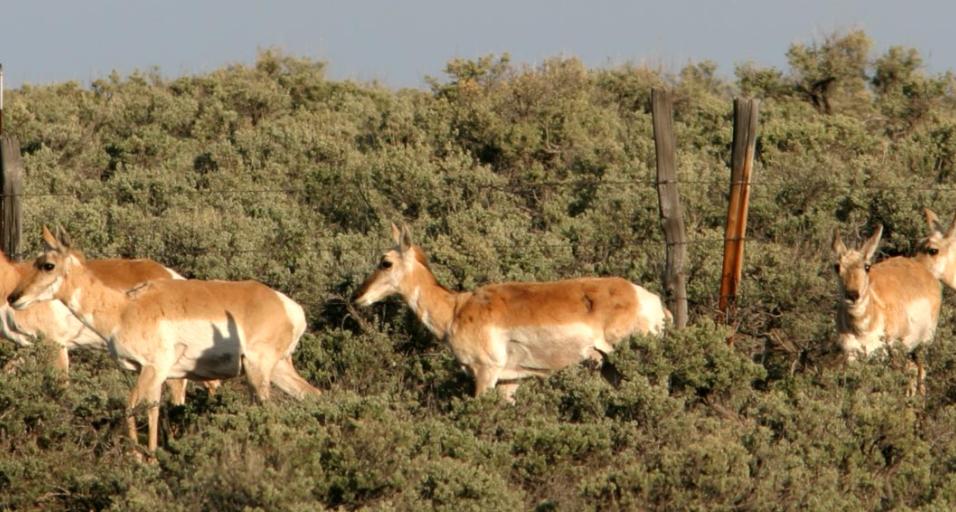Crossing the Road
Or, you’ve come across an injured animal that survived a collision but is in bad shape.
More times than I can count, I’ve had near misses with wildlife on Wyoming’s roadways. And conservative estimates indicate that on about 6,000 occasions each year, Wyoming motorists collide with one of our state’s treasured wildlife species. During my 20-plus years working as a game warden, I remember the hundreds of responses to handle injured wildlife as some of the most undesirable parts of an otherwise incredibly rewarding job. These experiences evoke similar emotions for most involved: shock, frustration and usually some sense of loss. It seems very wasteful, both in terms of a damaged vehicle and the loss of wildlife. And unfortunately in rare cases, people are hurt.
Our state’s value for wildlife, concerns for public safety, and everyone’s interest in preventing property loss prompted multiple groups to study the issue further. Concerned people from across the state rallied in typical Wyoming fashion and brainstormed ideas and considered approaches to address this problem. The work of a broad stakeholder group and increased awareness of the issue inspired the Wyoming legislature to pass a law creating a wildlife conservation license plate with funds generated from the plate dedicated to wildlife crossings. Through some exceptional teamwork by the Wyoming Game and Fish Department and the Wyoming Department of Transportation, about 40 priority wildlife crossing sites and an additional 200 sites were identified around the state.
The Wyoming Game and Fish Commission has responded by committing to put money on the ground now to address the highest priority crossing projects. At their April meeting, the Commission dedicated $1.25 million as seed money to start a new project.
With the Commission’s allocation of funds, the awareness created by the wildlife conservation license plate and the statewide interest, there is momentum. Wyoming has a strong track record of completing these kinds of projects. Trappers Point overpasses west of Pinedale, underpasses at Nugget Canyon and underpasses near Baggs are all examples of how effective this kind of work can be.
These projects require big money. I am hopeful that a desire to improve public safety on roadways, interest in our wildlife and a desire to reduce wasteful property loss will increase momentum and inspire a generation of resources.
So I urge you to get involved. Talk to your friends about the issue, engage local conservation groups, help with fundraising or donate yourself. Together, let’s move on some of these projects.
More times than I can count, I’ve had near misses with wildlife on Wyoming’s roadways. And conservative estimates indicate that on about 6,000 occasions each year, Wyoming motorists collide with one of our state’s treasured wildlife species. During my 20-plus years working as a game warden, I remember the hundreds of responses to handle injured wildlife as some of the most undesirable parts of an otherwise incredibly rewarding job. These experiences evoke similar emotions for most involved: shock, frustration and usually some sense of loss. It seems very wasteful, both in terms of a damaged vehicle and the loss of wildlife. And unfortunately in rare cases, people are hurt.
Our state’s value for wildlife, concerns for public safety, and everyone’s interest in preventing property loss prompted multiple groups to study the issue further. Concerned people from across the state rallied in typical Wyoming fashion and brainstormed ideas and considered approaches to address this problem. The work of a broad stakeholder group and increased awareness of the issue inspired the Wyoming legislature to pass a law creating a wildlife conservation license plate with funds generated from the plate dedicated to wildlife crossings. Through some exceptional teamwork by the Wyoming Game and Fish Department and the Wyoming Department of Transportation, about 40 priority wildlife crossing sites and an additional 200 sites were identified around the state.
The Wyoming Game and Fish Commission has responded by committing to put money on the ground now to address the highest priority crossing projects. At their April meeting, the Commission dedicated $1.25 million as seed money to start a new project.
With the Commission’s allocation of funds, the awareness created by the wildlife conservation license plate and the statewide interest, there is momentum. Wyoming has a strong track record of completing these kinds of projects. Trappers Point overpasses west of Pinedale, underpasses at Nugget Canyon and underpasses near Baggs are all examples of how effective this kind of work can be.
These projects require big money. I am hopeful that a desire to improve public safety on roadways, interest in our wildlife and a desire to reduce wasteful property loss will increase momentum and inspire a generation of resources.
So I urge you to get involved. Talk to your friends about the issue, engage local conservation groups, help with fundraising or donate yourself. Together, let’s move on some of these projects.
Sara DiRienzo (307-777-4540)

